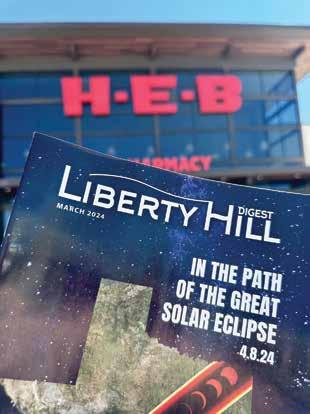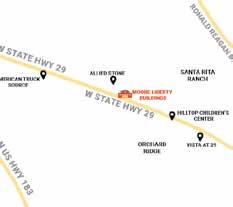RAPID RESPONSE FOR RAPID GROWTH
New Medic Station For Fire Station 2


WHIMSY, WONDER & WHISKEY
Festival Premieres
Secret Speakeasy

RAPID RESPONSE FOR RAPID GROWTH
New Medic Station For Fire Station 2


WHIMSY, WONDER & WHISKEY
Festival Premieres
Secret Speakeasy
KICK UP YOUR HEELS, TEXAS STYLE Dances That Are Better With Boots On



Omnia Outdoors is far more than just a pool builder. We truly cater to our customer’s comprehensive vision for their entire backyard experience. “Omnia” is the Latin word for ALL THINGS which is exactly what we provide – “ALL THINGS OUTDOORS”.


LANDSCAPES to schedule your free design consultation!
We are the ultimate design-build source for Swimming Pools and Spas to Landscaping and Irrigation, Outdoor Living, Cabanas and Pergolas, Outdoor Kitchens, Artificial Turf, Stone Masonry, Outdoor Lighting and even Patio Furniture and Accessories provided by Omnia Lifestyles.




PUBLISHER
Cathy
Payne
Like many of the best in her craft, Cathy has a specialized degree—in her case, hard science—and a gift for writing. She found her voice and fulfillment reporting and writing news and magazine features for a regional Central Texas audience. Along with serving as the publisher of the Liberty Hill Digest, Cathy oversees multiple magazines, marketing campaigns, and books.
SENIOR WRITERS / COPY EDITORS
Ann Marie Kennon
Charlotte Kovalchuk
CONTRIBUTING WRITERS
Linda A. Thornton
Rachel Strickland
GRAPHICS & DESIGN
Sandra Evans
Zion Eaton
CONTRIBUTING PHOTOGRAPHERS
Christina Tucker
Christianna Bettis
IT/WEBMASTER • Jesse Payne
CONSULTANT • W. Ben Daniel
ADVERTISING
Nick Spence • nick@lhtxdigest.com Office: 512-746-4545 Cell: 737-349-8366
In an age where the rush of daily news often overshadows the deeper narratives that shape our community, the Liberty Hill Digest constantly strives to be an eager beacon of positivity and unity. Far more than just a lifestyle magazine, our publishers and staff are committed to creating a means of getting to know what makes our community thrive: its people and their impact.
Since its inception in 2020, the Liberty Hill Digest has not only reported on more than 550 of the great stories and people in our city, we have also taken pride in actively contributing to its enrichment by mailing more than 405,000 magazines for free in the last four years.
Moreover, we enjoy sharing our commitment to the animal companions of our community through regular features dedicated to the Williamson County Regional Animal Shelter, showcasing the importance of compassion. We are also pleased that our rotating nonprofit column further underscores this dedication by highlighting different support organizations each month like L4 Cares, creating a platform for advocacy and connection.
But we are also good at doing what we do – showcasing prominent community agencies and initiatives like Operation Liberty Hill, Liberty Hill ISD students, FFA, 4-H, and many more on our covers and in multi-page features. These not only celebrate their contributions but also inspire readers to engage personally and participate in the missions of these community pillars. As well, timely articles featuring local events like Whimsy & Wonder, the City of Liberty Hill, and the involvement of our local businesses in the community go beyond surface-level news, offering insights into the cultural and humanitarian assets of Liberty Hill.
In every story, from first responders and veterans to the latest city events and programs, our purpose is to foster a sense of pride and connection. In addition to these, each November, our Giving Thanks and Giving Back issue shines a spotlight on local nonprofits and philanthropic efforts, reminding us of the power of community support and the importance of gratitude.
Liberty Hill Digest isa FidelisPublishingGroup,LLCpublication andaproductof AdvocateNewsTXNewspaper. Copyright © 2024
All rights reserved. Liberty Hill Digest is published monthly and mailed USPS, free of charge, to homes and businesses in Liberty Hill, TX zip codes. Mail may be sent to Liberty Hill Digest, P.O. Box 213, Jarrell, TX 76537. Email: info@lhtxdigest.com
In short, we believe the Liberty Hill Digest is more than a magazine; it is a vital part of the community’s fabric that spotlights advocacy, education, and celebration. We hope you will agree it stands as a testament to what we can all achieve when we choose to focus on the positive and the possible.

Meet our Experts - professionals, business owners, and subject matter experts from leading local companies who share their knowledge and expertise to bring readers practical advice, how-to tips, best practices, and current and emerging trends. To learn more about becoming an Expert, contact nick@lhtxdigest.com or 737.349.8366.




BLINDED BY THE LIGHT & HUNTER DOUGLAS DEALER • DEB LOHMAN
Owner of a lifestyle home décor boutique specializing in Hunter Douglas window coverings to include soft shades, blinds, and shutters.
BlindedByTheLightDecor.com 512-636-9653
DUVALLS BOUTIQUE
Specializing in children and womens apparel with an emphasis in higher-quality and natural fabrics.
DuVallsBoutique.com • 109 S Hwy 183, Leander
GEORGETOWN FENCE & DECK
We complete hundreds of projects annually and are dedicated to creating exceptional outdoor living spaces that provide years of enjoyment and add value to your home.
GeorgetownFenceAndDeck.com • 512-948-7539
GREEN DREAM LAWN CARE • DOUG DURDEN, BRANCH MANAGER
Over three decades in turf management, with roles as Service manager, Branch manager, Regional Agronomist and GC Superintendent at renowned companies. info@GreenDreamLawns.com • @greendreamlawns
HANSON INSURANCE • EMILY HANSON
Sixteen local brokers, specializing in Medicare, and ready to assist with all your health insurance needs. NPN #18816155 HansonFirst.com • 512-817-6906
MOORE LIBERTY BUILDINGS • CHAD & AMANDA MOORE
Thousands of structures built since 2015. MooreLibertyBuildings.com • 512-548-6474


REID'S TRIPLE T
Locally and family-owned business specializing in tractors, trailers, zero-turn mowers and UTVs offering sales, parts and service. ReidTx.com • 512-379-4100
ROYAL BLISS DAY SPA
Liberty Hill's hometown spa since 2019, specializing in skin care, beauty and massage, and offering an extensive line of natural skin care products so you can continue your routine at home.
RoyalBlissDaySpa.com • 512-548-6733
SCHULTZE AGENCY • JEFF & JAIME SCHULTZE
Family-owned and operated local insurance agency proudly serving this great community. We specialize in personalized consultations for home, auto, life, commercial and specialty insurance. Call, text or come by and see us. 512-549-8700 • Agents.farmers.com/tx/liberty-hill/jeffrey-schultze



The Liberty Hill Digest was pleased to visit with Tom Maynard, distinguished member of the Texas State Board of Education (SBOE) for District 10, which includes 27 counties and most of Williamson County. Members of this pivotal elected board play a critical role in overseeing and shaping the educational standards and policies that impact the state's public schools. The SBOE is constantly working to improve educational outcomes for the state's 5.5 million public school students.
As a parent and grandparent, Mr. Maynard is particularly invested in the challenges and triumphs of the state education system. His strength as a board member is additionally born of his experience
as a CTE teacher, executive director of the nation's largest state FFA association, and local school board trustee. That experiential balance has given him expertise and a passion that enable him to prioritize educational needs with the values of Texas families in an ever-changing societal landscape.
Mr. Maynard notes the SBOE may be the most misunderstood elected body in the state. "A common misconception is that we have direct authority over schools or districts. In today's intensely political environment, frustrated people are looking for solutions and want to believe SBOE members can direct changes in schools, but SBOE members do not have authority to force decisions at the local level."
"Local school boards answer to local voters," he says. "State law defines the duties of the SBOE and State Commissioner of Education and what is not expressly or explicitly given in law to the SBOE or commissioner is given to local school boards. We are a local control, limited government state.”
One of the primary tasks of the SBOE is to develop standards that drive curriculum design, instructional materials, and assessments. These Texas Essential Knowledge and Skills (TEKS) define what students should know and know how to do in each grade level and subject area. State law prohibits the SBOE from dictating teaching methodologies or time for specific lessons.
"The ongoing battles over TEKS are significant because they are about what will be taught to the next generation," Mr. Maynard says. In the last few revision cycles, he recalls heated battles over health education standards, including a 16-hour public testimony marathon. "Among myriad proposals, most had to do with human sexuality and gender ideology," he says. "But we kept those things out of the standards."
Mr. Maynard notes content and material related to human sexuality are, pursuant to state law, the domain of local school boards working alongside a School Health Advisory Counsel. "State law was written to ensure local discretion on that subject," he says, "so if you read or hear something that claims SBOE acted on sex ed, you know it's misinformation."
He also noted that recently adopted science standards took a more measured, reasoned approach to climate change, adding language that prompts students to consider a cost-benefit approach to proposed climate solutions.
Many readers may remember some highly publicized textbook wars at the SBOE. They still occur but not at quite the same intensity, because the Legislature changed the rules of engagement. Until 2011, the SBOE held absolute authority over every textbook in every public classroom. All of that changed with the passage of SB 6 by the 82nd Legislature.

"SB 6 threw the door open, created an open-source environment allowing school districts to purchase whatever they wanted as long as they certified what they were buying with the instructional materials allotment covered all TEKS," he says. "We still had an adoption process, but schools were not obligated to purchase from our list. In fact, a school could buy and use materials that we rejected."
Mr. Maynard observes that there have been unintended consequences to this approach. "Some school districts have done a good job vetting and purchasing high quality materials, but some left it to their teachers to find their own. Much of this material is not high quality and some is not written at grade
level.” Mr. Maynard says he and other SBOE members were co-collaborators on the writing of HB 1605, which created a ratcheted-up process for reviewing instructional material.
HB 1605 also directs the SBOE to create reading lists for certain classes. "Your readers will remember being assigned books to read in class; these were generally classic works in particular literary eras or in particular genres," he says. "Not textbooks, but assigned reading, and recently we have observed what amounts to a culture war on western literature, which is a part of a larger war on western civilization," he says.
He also points out that HB 1605 also requires material vetted through this process to have a parent portal, guaranteeing 24-hour parental access to what is being presented to students.
One of the SBOE's key achievements is its involvement in the legislative process concerning library standards. Recently, many Texans became aware of school library books with graphic sexual content. SBOE members worked alongside Representative Jared Patterson to produce HB 900, a significant revision to the READER (Restricting Explicit and Adult-Designated Educational Resources) Act, which directed the Texas State Library and Archives Commission to create library collection standards that apply to school and classroom libraries.
For the first time, the SBOE had a voice in the process. "Prior to HB 900, the SBOE had no voice related to school libraries," he says.
Another critical but less discussed aspect of the SBOE's responsibilities is the management of the Permanent School Fund (PSF), the state's $55 billion endowment, which funds instruc-
tional materials and technology and is part of the overall school funding. Mr. Maynard has chaired the board's School Finance/PSF Committee since 2019 and in 2021 led an effort to bring the fund out from under the Texas Education Agency and into an agency similar to UTIMCO, a governmental corporation that manages the Permanent University Fund.
Mr. Maynard says, "The PSF now has the ability to operate more like the private sector," he says. "The fund has returned 7.25 percent over the past three years, adding $2.5 billion in value while distributing $6 billion, but we think we can do even better – generating more resources for Texas schools and perhaps alleviating the taxpayer burden.”
He is also proud of his efforts to rescue the PSF's bond guarantee program from a federal regulatory logjam that had stymied the fund for years. The PSF guarantees local school district bonds, ensuring that taxpayers pay the lowest possible interest rate. "That program saves Texas taxpayers $300-400 million in interest payments," he says.
However, the IRS rules had limited capacity of the PSF to guarantee bonds, based on a 2009 valuation of the fund. Mr. Maynard led a bipartisan effort to have legislation filed to exempt the program from these regulations and allow state law to govern it. "We had nearly the entire Texas congressional delegation on board as co-sponsors and were able to leverage that to get the IRS commissioner to yield on the matter," Mr. Maynard says.

Scan the code for more information about the SBOE.


Dreaming of a quiet office space just steps from your home? Want to move mom close but not inside your home? Ready for a backyard entertainment space? Small accessory structures, separate from your main dwelling, are quite popular in Williamson County. If you've been thinking about building one of these versatile structures but don't know where to begin, these key considerations will help you understand where to start.
First, some definitions:

Shed: A structure primarily used for storage. Unfinished interior with exposed studs, rafters, and sub floor. Electrical is sometimes added, plumbing is not included.
1. ARE YOU ALLOWED TO BUILD AN ADU ON YOUR PROPERTY?
Outside city limits, no HOA/POA – usually yes. Check your property survey for any easements, building setback lines, or other restrictions regarding building placement.
Outside city limits, inside a neighborhood HOA/POA – it depends. Check with your HOA. One large, local, master-planned community requires sheds to be no taller than 8', while it allows ADUs to be over 11' tall! Typically, you’ll want a roof height of at least 10' to provide a comfortable indoor space.
Inside city limits – you will need to check with the city to see if ADUs are allowed in your neighborhood. Cities are concerned about overall size, height, access, and permits. Yes, you will have to obtain permits when building inside city limits.

Accessory Dwelling Unit (ADU) / Casita / Home office: Though they have different names – usually assigned based on intended use – these structures are fully finished with insulation, wall coverings, flooring, HVAC, electrical, and sometimes plumbing.
2. DO YOU HAVE ENOUGH POWER?
ADUs typically need 60-100 amps of electrical power. An electrical inspection will determine if you have ample capacity to handle this additional load.
If you don't have enough power, you will need to upgrade your service.

3. WHAT ABOUT A BATHROOM?
If you're on a septic system, then you need to consider if you are adding load or just shifting it from using a bathroom in the house to the new building. Any septic changes are governed by a permit from the county.
If you're on a sewer system, then you'll tie the ADU wastewater into the sewer. Depending on where that drainpipe is located on your property, that can entail trenching through much of your property to make the connection.
Fresh water will also have to be routed from an accessible location on your property to the new building.
4.
If you have the space and clearance to build an ADU, then you need to look at a budget.
A basic backyard office/workshop/ hobby space is going to start around $30,000.
A complete one-bedroom, onebath casita with a kitchen is going to be pushing $150,000, if not more, depending on driveways, masonry, electrical, and plumbing connections.
Whatever name you give your dream building, tackle these steps and you’ll be on the way to realizing your dream and hearing, “It’s movein day!”

With its humble beginnings as a small group of committed volunteers, Liberty Hill Fire Station 2 has grown right in line with the area’s population – enough to warrant the addition of a new medic station. Established in 2001 with Emergency Service District funding, they hired their first full time firefighters in 2003 who each worked as a one-man crew alongside volunteers.
In 2018, Liberty Hill Fire Station 2 was built at 22799 Ronald Reagan Boulevard. It now supports a team of 48 firefighters, divided into three shifts of 16 members each, along with an administrative staff of nine. Additionally, Williamson County EMS recently introduced a medic station at this location.
Covering 126 square miles that include all of Liberty Hill and sections of Burnet, Georgetown and Leander, Williamson County ESD #4 has experienced a population swell since 2020. In Santa Rita Ranch alone, the population has increased by about 85 percent to a current population of 4,145.
The fire department’s vehicle tracking system assigns the closest ambulance to a call. At times, this could mean firefighters traveling out of their district, if need be. Fire Chief Anthony Lincoln says 35 percent of the time, calls are double-stacked, with ambulances receiving two calls at the same time to two different locations.
In an effort to improve response times, the new medic station was a welcome and necessary addition. Funding of $1 million was allocated to finance an ambulance and support two paramedics available around the clock. Following the initial investment, annual operating costs of $800,000 will be absorbed into the general fund budget. Williamson County EMS took charge of hiring and training the medics, while Fire Station 2 was equipped to provide living quarters and office space. The station was thoughtfully designed with future expansion in mind, capable of accommodating up to 10 personnel.
Though all firefighters are trained as emergency medical technicians (EMTs), Chief Lincoln says having a dedicated ambulance and two 24/7 paramedics is a game changer. These pre-hospital clinicians are the first on scene to triage a health care crisis and are a critical component of the emergency management system of a coordinated response. Their 9-1-1 calls may be as simple as transporting a person to the ER who is not feeling well, as grave as cardiac arrest or a car accident, and everything in between.
Having just celebrated a ribbon cutting for the new medic station on April 11, Liberty Hill is not resting on its laurels. The county plans to open another fire station in April 2025 and has already purchased land for two more, with a total of 10 to 12 stations anticipated to meet Liberty Hill’s future growth.










From the addition of swim lessons and pool improvements to yet another anticipated Beat the Heat celebration, Jamie Higuera is looking forward to all the exciting things that will kick off the Liberty Hill Swim Center’s second season.
“We’re excited to have people come back, and we wanted to do more this year,” the Parks, Recreation & Facilities supervisor says.


The swim center will open on May 25 and this year, pool visors can enjoy additional shaded structures, picnic tables, and lounge areas as well as extra decking that will provide more space for lounge chairs.
In contrast with last year’s ice-themed Beat the Heat grand opening celebration, this year’s pool opening party will have a fire theme with party dancers decked out in red, a fire truck and firefighters from the Liberty Hill Fire Department that kids can interact with, and food vendors like Hot Diggity Dog and a Country Creamery ice cream truck. “It’s just a fun and unique way to celebrate so we wanted to bring it back year after year. It will probably be our big beginning pool event for each summer,” Jamie says.
251 CR 200 | Liberty Hill ExperienceLHTX.com/Liberty-Hill-Swim-Center
An exclusive party is in store for season pool pass holders on Monday, July 15, featuring hula dancers, a tiki bar with Hawaiian punch, a live DJ, and luau-themed food trucks. Pool passes are available for sale at https://secure.rec1.com/TX/ liberty-hill-tx/catalog.
Monday: CLOSED
(Except Memorial Day & Labor Day) Tuesday - Saturday: 10am - 7pm Sunday: 1pm - 6pm



Whimsy and Wonder is set to enchant Liberty Hill at 6-10pm on May 18.

During the 1920s’ Prohibition era, private, unlicensed barrooms nicknamed “speakeasies” popped up in many businesses. Patrons had to speak a password to gain entry so as not to be overheard by law enforcement. Often, business owners would exploit low-paid police officers with payoffs to look the other way. With this year’s Whimsy and Wonder’s subtle 1920s theme, and “as a nod to the historic buildings downtown, we thought it would be super fun to add a speakeasy, since Whimsy is all about surprises!” Director of Community Engagement & Communications Katie Amsler says.
Not only will festival goers have to discover the location of the speakeasy, they will also need to know the password and the phrase to get the password. The speakeasy is exclusive and only 75 guests ages 21+ will be permitted throughout the evening. Katie revealed one clue: “A man whose beard shimmers in the moonlight holds the answers.”
“I’m super excited to add this element of surprise and mystery to the festival!” she adds. “This year, people can expect a little more interaction with the street performers, and I can’t wait to see how they all work together, along with downtown business owners and City staff for a more immersive experience along Main Street.”


Welcome to summer 2024! The Williamson County Regional Animal Shelter (WCRAS) is excited to help you give back to the community by getting involved at the shelter. Warmer temperatures mean more animals at the shelter on a regular basis, and that means it’s a great time to sign up to be a volunteer.
In 2023, the shelter took in 6,484 dogs and cats, and caring for them all takes a village – one made up of staff, volunteers, and fosters. The facility had 518 active volunteers who gave more than 24,000 hours of their time

to help staff continue the lifesaving mission of caring for each animal that comes through the doors and is awaiting a loving new home. “We are simply humbled by the amount of effort our volunteers put into helping the shelter, and still, there are never too many of them,” WCRAS Community Programs Coordinator April Peiffer says. “Every extra hand lightens the workload for everyone else. Plus, the volunteers get the best rewards for their efforts –puppy breath, tiny kitten purrs, wagging tails, and biscuits from the cats – all ways the animals show their love and thanks to the volunteers.”
There’s a way to help for any skillset!
Got a hidden talent for:
Walking dogs,
Socializing dogs and cats,
Fostering a dog or a family of kittens,
Cleaning kennels, helping with laundry, or other special administrative tasks,
Working at off-site events,
Helping with photography and videos of shelter animals,
Assisting with special projects; e.g., assembling shelves, doing research, or data entry
WCRAS has a way you can put that talent to use for the shelter pets. April says, “An animal shelter consists of many moving parts, each of them working together to ensure the best outcome for each animal, and there's an opportunity for volunteerism every step of the way.”


The Texas two-step began evolving from the foxtrot in the 1920s. The brisk “slow, slow, quick, quick” steps known to ballroom dancers as the international foxtrot are said to be related to the polka, Texas waltz, and the jitterbug. With no traveling turns or spins, it’s one of the easiest dances to learn and aspiring dancers need only head to Broken Spoke in Austin on an evening when dance lessons are held to master the movement.
In addition to great dancing, the ambiance and décor at the Broken Spoke virtually transport visitors back to 1964, when James W. White first opened the dance hall. Today, his daughter, Terri White, is whipping two-steppers into shape with a no-nonsense, sassy, quasi boot camp style of teaching. And, like a proud mama, she enjoys watching from the sidelines as her students glide around the dance floor to live music.
“Dancing is a perpendicular expression of a horizontal desire” - George Bernard Shaw
The waltz began as a dance for European aristocracy and, to this day, this very traditional dance style still can make one feel like royalty at a ball. Composed of sway, rise, and fall, couples turn and make their way around the perimeter of a dance floor, always in the same direction. Punched up with some country music, the Texas variation combines elegant steps with sing-along music.
For a great waltz experience, head to Luckenbach, the old western-style town outside of Fredericksburg made famous by Willie, Waylon and The Boys. There, visit the Luckenbach Dance Hall, which has been drawing crowds since 1887, and you can waltz alongside as many as 500 other dance enthusiasts.
While there are many styles around the world, this European tradition was brought to Texas by early settlers. Its long association with the American cowboy led the late Governor Ann Richards to sign a proclamation in May 1991 designating square dancing as Texas' official folk dance.
Danced by four couples in a square, two are identified as “heads” and two are “sides.” A caller cues dancers through a sequence of steps. In some variations, dancers have no caller, having memorized the routines, as they “sashay, promenade, and allemande left” on their own.
Consider do-si-do-ing at Billy Bob’s Texas, the world’s largest honky tonk located in the Fort Worth Stockyards. With 100,00 square feet of interior space, it also boasts nearly 20 acres of parking space.
Clothes make the dancer
The summer sun does not seem to affect what a Texan will wear to dance. Cowboy hats, boots, belt, jeans, a western shirt or dress, fringe – some say just dressing up Texas style makes you a more proficient dancer.

Originating in Europe, this dance style became popular in the western United States in the 1950s.
Dancers stand side by side in a line, all facing in the same direction and performing the same steps simultaneously. The sequence of steps is choreographed to a specific song; e.g., the Macarena, Electric Slide, and Elvira.

You can try out these skills at Gruene Hall, located in the historic district just outside the New Braunfels city limits. Opened in 1878, it is Texas’ oldest continuously operating dance hall. Dancers can catch live music nearly every day and night but remember the main rule: never walk through a block of dancers!
At any given time, in many places around Texas – from a coffee shop to food truck park to street corner –there is a delightful possibility that you will be treated to live music. Where there’s music, dancing will not be far behind and there are many ways to do it Texas style.














As an experienced aesthetician, I can explain the benefits of medical grade skin care versus non-medical grade skin care with three key points of discussion.
The benefits of medical grade skin care over non-medical grade products include:
higher concentrations of active ingredients,
clinically proven formulations, and
customized treatment plans that can result in more effective and targeted skin care results.
Medical grade skin care products typically contain higher concentrations of active ingredients such as retinoids, vitamin C, and hyaluronic acid. These ingredients are scientifically proven to be effective in addressing various skin concerns like anti-aging, hyperpigmentation, and acne. The higher potency of these ingredients in medical grade products can lead to more visible and quicker results compared to non-medical grade products.
Medical grade skin care products undergo rigorous testing and clinical studies to ensure their safety and efficacy. These products are often formulated by dermatologists or skin care professionals who understand the science behind skin care. The formulations are backed by scientific research and are designed to penetrate deeper into the skin to target specific skin issues. This level of quality assurance is not always present in non-medical grade products.
When you choose medical grade skin care, you are more likely to receive personalized recommendations and treatment plans tailored to your specific skin concerns. Dermatologists and skincare professionals can assess your skin condition and recommend products that are suitable for your unique needs. This personalized approach can lead to better results and a more targeted skin care routine compared to using generic non-medical grade products.

Royal Bliss Day Spa
Liberty Hill's hometown spa since 2019, specializing in skin care, beauty and massage, and offering an extensive line of natural skin care products so you can continue your routine at home. RoyalBlissDaySpa.com • 512-548-6733

Bats often get a bad rap because of their portrayal as spooky Halloween-time creatures and ties to their blood-sucking Transylvanian relative. But, in reality, bats are remarkable animals, serving as vital, unsung heroes of the ecosystem. As you plan your summer trips, be sure to add a visit to one of the many, awe-inspiring bat hideouts around Texas.
Bats are essential to our environment because they pollinate flowers and disperse seeds. In fact, more than 300 types of fruit and plants depend entirely on bats. So, because of our flying friends, we have bananas, mangoes, avocados, and cacao. Plus, while these fruits and plants serve as sustenance for humans and animals, they're also important ingredients in more than 80 medications.
Not only do bats help pollinate fruits and plants, they also eat tons of pesky insects, which has saved the farming industry billions in crop damage and pesticide costs. Plus, guano (bat poop) is helpful as a highly effective fertilizer. It's safe to say the world we live in today would not be the same without bats, which is why there are many laws protecting them.
Now that you know how incredible bats are, you might want to see one — or one million — in action. Fortunately, there are plenty of spots in Texas where you can do just that as the Lone Star State is home to thousands of Mexican free-tailed bats. This medium-sized bat migrated to the United States from Mexico and mainly eats insects, including moths, flies, wasps, and mosquitoes. They are typically visible from early spring through early fall.

f Bats are part of the mammal order Chiroptera, which has more than 1,400 species making it the second largest and most diverse order of mammals after rodents. Bats are the only mammals that can fly — some can even go as fast as 100 miles per hour.
f Contrary to popular belief, bats are not actually blind but rely on echolocation – locating objects by emitting sound waves and interpreting the echoes reflected back to them – as their primary sense. Some bats use echolocation to hunt live prey, while others simply feed on fruit or nectar.
f Like most mammals, bats come in all shapes and sizes. The average bat’s wingspan is about 24 inches; the largest can be as large as 5 feet, while the smallest are only 6 inches and the animal can fit in the palm of your hand.
f Bats are highly social animals that usually reside in groups. They are best known for their unique habit of sleeping upside down. This position is advantageous as it facilitates a quicker and easier departure into flight, since bats are unable to gain momentum through running. Hanging upside down allows them to simply drop and swiftly take off.
f Several species of bats have been known to live more than 30 years, and the oldest on record is a venerable 41-year-old Siberian bat.
f Bats are gentle, nocturnal animals, feeding at night when it's cooler. Their diets differ depending on the species—some eat insects, fruit, or nectar, while others feed on the blood of wild animals such as cattle or horses. But don't worry — they rarely bite humans unless threatened.

Following renovations in 1980, the Congress Street bridge became a perfect roost for Mexican free-tailed bats, who help the city by consuming and estimated 30,000 pounds of insects each night. Starting in late March, you can watch these prodigious bats emerge from beneath the bridge, soaring over Lady Bird Lake between 7:30 and 9:45 pm. Prepare to enjoy watching the emergence of a nearly 1.5 million-strong cloud for about 45 minutes. Join the gathered crowds on the nearby hill or enhance your experience with a riverboat tour or kayak to watch this nightly phenomenon.

Located on South Congress Ave, just a 40-minute drive from Liberty Hill.
If you want even more, the Bracken Cave on the northern outskirts of San Antonio is home to an estimated 20 million bats. In 1991, the Bat Conservation International (BCI) purchased the Bracken Cave, and it is not only the world’s largest bat colony, it is also the largest concentration of mammals of any kind. The Bracken bats consume an estimated 100 tons of earworm moths every night. Because Bracken Cave Preserve is located on private property managed by the Bat Conservation Interaction, it is closed to the public and reservations must be made to see the bats. However, once the bats start flying, they can be seen easily from nearby streets. 7515 Bracken Cave Rd, San Antonio, 2-hour drive from Liberty Hill.
Every night between March and November, hundreds of bats embark on a nightly bug hunt from under the Interstate 35 overpass at McNeil Road in Round Rock. Free, first-comefirst-served parking is available in the nearby Napa Auto Store parking lot. 601 North Interstate 35 Frontage Road, Round Rock, 45-minute drive from Liberty Hill.

Approximately 100,000 bats live under the Watonga Boulevard Bridge in downtown Houston. They typically fly out from under the bridge and along the White Oak Bayou. Many viewers enjoy watching the sight from park benches or the grass along the bayou. 4721 Watonga Blvd, Houston. 3-hour drive from Liberty Hill.
More than 3 million bats reside in the tunnel in Fredericksburg. The park is open for bat viewing from May through October, but tickets are required for park access after 5pm. 10619 Old San Antonio Rd, Fredericksburg, 1.5-hour drive from Liberty Hill.

Lavender is an enchanting but often overlooked ingredient in the kitchen. When used well, it provides a delicate floral note with hints of mint or rosemary, creating a unique taste. Be careful to use it sparingly to avoid overwhelming a dish with soapy flavor.
• 3 cups all-purpose flour
• 2 1/2 tsp baking powder
• 1/2 tsp baking soda
• 1/2 tsp kosher salt
• 2 cups sugar
• 2 tbsp lemon zest (from about 4 lemons)
Preheat oven to 350°F.
Grease two (8-inch) round cake pans with butter. Line pans with parchment paper, then grease and dust parchment with flour.
In medium bowl, whisk flour, baking powder, baking soda, and salt.
In food processor bowl, add sugar, lemon zest, and dried lavender. Process sugar mixture 1-3 minutes until lavender is finely ground and zest and lavender are distributed throughout the sugar.
Beat butter, vegetable oil, and lemon-lavender sugar on medium-high until very pale and fluffy, about 4 minutes. Mixture volume should double or nearly triple.
Add eggs, one at a time, beating until fully combined after each addition. Scrape bottom and sides of bowl with a rubber spatula. Stir in vanilla extract.
Add half the flour mixture into butter mixture and mix on low until incorporated. Pour in milk and lemon juice and continue mixing on low until combined.
Add remaining flour mixture and mix on low just until incorporated. Use rubber spatula to scrape bowl between additions to ensure even mixing.
• 1 tbsp dried culinary lavender
• 1/2 c unsalted butter, room temp
• 1/2 cup vegetable oil
• 4 large eggs, room temperature
• 1 tsp vanilla extract
• 1/3 cup fresh lemon juice
• 1 cup whole milk
Divide batter evenly between two prepared cake pans. Bake 30 to 35 minutes, or until a toothpick inserted in the center of the cake comes out clean. Edges of cake will have begun to pull away from the sides of the pan, and center should spring back when gently poked with a finger.
Let cakes cool in pans for 15 minutes, then turn out onto a wire rack to cool completely before frosting.
In a stand mixer fitted with the paddle attachment, or in a large mixing bowl with a hand mixer, beat butter on medium speed until smooth and satiny, about 2 minutes.
Add powdered sugar, half of the milk, and lemon extract and continue beating on medium speed until light and fluffy, about 2 minutes. If too thick, add more milk, 1 tablespoon at a time, until it reaches the desired consistency.
Place one of the cake layers rightside-up on a large plate or a 10inch cardboard cake round. Use an offset spatula or a butter knife to spread a thick layer of frosting, 1/2 to 1 cup, evenly over the layer.
• 1 1/2 cup (3 sticks) unsalted butter, room temperature
• 6 cups powdered sugar
• 1/3 cup whole milk
• 1 tbsp lemon extract
Top with the remaining cake layer, placed upside down, so the top of the cake is smooth and flat. Check that the cake layers are centered and that the top of the cake is level. Gently adjust accordingly.
Spread a generous amount of frosting over the top and sides of the cake using an offset spatula or the straight edge of a large butter knife. Use spatula to spread the frosting into a thin, even layer. You should be able to see the cake through the frosting.
This thin layer of frosting is called the crumb coat and helps catch any loose crumbs on the outside of the cake so the final layer of frosting has no crumbs caught in it.
Place the cake in the refrigerator for 20 minutes for the frosting to set. Cover the bowl of frosting.
Remove cake from the refrigerator. Stir the frosting a few times to smooth it out again.
Spread a generous amount of frosting over the top and sides of the cake as before, this time leaving a thicker layer of frosting. Use the offset spatula, a large spoon, or the back of a butter knife to smooth the sides.

Offer a range of sparkling wines to cater to different tastes. Include traditional options like Champagne or Prosecco, and consider adding a domestic sparkling wine for variety.
Non-Alcoholic Options: For those who prefer non-alcoholic beverages, include sparkling water or non-alcoholic sparkling wine.
Orange juice is a must, but don’t stop there. Offer peach, pomegranate, grapefruit, and cranberry juices for colorful and tasty options.
Freshness Counts: Opt for high-quality, freshly squeezed juices, if possible, for a noticeable difference in flavor.
Slice fresh fruits like strawberries, raspberries, blueberries, and orange slices. Not only do they add flavor, but they also make the drinks visually appealing.
Herbal Touches: Offer fresh herbs such as mint or basil for an aromatic twist.
Use clear pitchers or carafes for the juices and bowls for the fruits and herbs to create an elegant display.
Glassware Matters: Have an ample supply of flutes or glasses available, ensuring everyone can partake.
Label Everything: Use labels or small signs to identify the different juices, wines, and garnishes. This helps guests create their perfect mix without guessing.
Ensure all beverages are well-chilled before serving. Use ice buckets for the wines and keep juices in the refrigerator until just before serving.
Ice on the Side: Have a bucket of ice on the side for guests who prefer their mimosa extra cold.
Ensure there are plenty of non-alcoholic options available for those who prefer them or are driving.
Hydration Station: Set up a water station with still and sparkling water to keep guests hydrated throughout the celebration.

Frittatas are versatile, easy to make, and can feed a crowd, making them perfect for a brunch celebration. This recipe pairs nicely with a side salad, fresh fruit, or crusty bread.
• 8 large eggs
• 1/2 cup whole milk or cream
• 1 cup grated cheese (cheddar, Gruyère, or feta)
• Salt and pepper, to taste
• 2 tbsp olive oil
• 1 small onion, thinly sliced
• 2 cloves garlic, minced
• 1 cup asparagus, trimmed and cut into 1-inch pieces
• 1 cup cherry tomatoes, halved
• 1 cup baby spinach or arugula
• 1/4 cup fresh herbs (such as parsley, chives, or basil), chopped
Preheat oven to 375°F.
In a large bowl, whisk together the eggs, milk, half the cheese, salt, and pepper. Set aside.
Heat olive oil in a 10-inch ovenproof skillet over medium heat. Add onion and garlic, and sauté until soft. Add asparagus and cook until just tender. Stir in cherry tomatoes and spinach (or arugula) until greens are wilted.
Pour egg mixture over sautéed vegetables in the skillet. Stir gently to make sure ingredients are evenly distributed. Sprinkle remaining cheese on top.
Transfer the skillet to the oven and bake 20-25 minutes, or until the frittata is set and golden on top.
Remove from oven, let cool for a few minutes, then sprinkle with fresh herbs. Slice and serve warm or at room temperature.

Just walked back into the house brushing ants and dog hair off my clothes because I didn't plan well enough for lying on my back to take photos of the eclipse. I did think enough ahead of time to find a flat space to hold my camera straight up without getting a crick in my neck but didn't have enough sense to bring a blanket with me or leave the dogs in the house. Still, it was kind of cool to see the pups suddenly settle down when the sky got dark. Apparently they didn't think it was the Rapture either so they just momentarily chilled out.
It got me thinking though about how nice it is, however infrequently, when we humans experience something we all enjoy or at least seem to agree on. Sure, many went about their day today without giving the cosmos a second thought. Others live far away from the path of totality and have been blissfully free from daily updates about retinal blindness and emergency planning for the past month. Then there is my mom, who lives on the east coast and happened to call me on another topic. When I told her what I was up to today she responded, "There's an eclipse? I thought that was last night."
Before you ask — no, my mom is not AOC, she's just old, has a new boyfriend, and doesn't think or talk about anything else these days. But that's a whole other Belle column you don't want to read.

Back to lighter thoughts, I can only remember a few times in recent history that the news cycle was ablaze with an ultra compelling story that no one was conflicted about or debating in my doom scroll. The sad death of Betty White for instance. Everyone loved her, four living generations of television viewers appreciated her in prime time shows that were popular in their own decade, and she rescued animals for most of her life. The only thing people complained about that week was that she was three weeks away from her 100th birthday. Good job, Humans.
I think we can all agree that watching Kaitlin Clark, likely the only female basketball player most of us can name, was a joy. Not just because she is a GOAT, but because she is classy in so many ways. Everyone is celebrating her these days and to paraphrase USC Coach Dawn Staley, she has carried the weight for and elevated her sport for some time. Everyone loves her otherworldly athleticism.
But the universality of the eclipse was something even beyond Betty and Kaitlin. It provided free admission for an estimated 50 million people who all had a front row seat just by looking up. Thousands of photos, which began popping up on the Internet early in the morning showed scenes from all over that looked like modern day Norman Rockwell portraits. There were people wearing special outfits, with painted faces and whimsical eye protection, from all walks of life, standing shoulder to shoulder with eager and smiling faces uplifted.
From the sides of roads to midfield in professional sports arenas, everyone had a good seat when the moon did the ultimate photobomb.
Still, what I really loved was the idea that normally we are all so obsessed about daily duties and things that, in the grand scheme, are just things to get us to the next day. We panic over elections, fixate on fightin' words on social media, and devote so much of our attention to keeping our homes, cars, gardens, and pantries just so. Yes, those last things are necessary but an overfocus on them means we regularly fail to look up and ponder how insignificant our little rock hanging in space really is.
It was a great moment of connection for those 50 million families, CEOs, first responders, bikers, politicians, and everyone else...all stopping in their tracks to look at each other, even for a moment, then marvel at the amazing preciseness of an indecipherably broad universe. Perhaps some of those people were thinking about Psalm 8:4, asking, “What is man that you are mindful of him?”
Imagine how different things could be could be if we all carried that humility vibe with us every day. Life isn’t just about what we think we’re achieving with our mundane tasks. It’s about something — or Someone — way beyond our little bubble. He kicked off this whole show with a word, and here we are, just passengers for a time on a little rock.
It was a great four minutes wasn't it?








In April, 25 Liberty Hill panthers exhibited dedication and passion for their sports in the Special Olympics Area/ Regional Track meet at Bible Stadium in Leander. Students ages 8 to 22 gave it their all during sprints, jumps, shot put, tennis ball throw, softball throw, and relays. “Watching Special Olympic athletes compete is an incredibly uplifting and inspiring experience,” says Rachel Acosta, LHISD's director of Communications & Community Engagement. “These athletes demonstrate tremendous dedication, skill, and passion for their sports, and their performances are awe-inspiring.”




On top of that, she adds, “having LH alumni represent their adult teams was amazing.” Madison Cochran, a paraprofessional at Liberty Hill High School, was able to inspire some of the students she helps at school, while one of LHISD's first Special Olympic athletes, Walker Raney, wore a Panther gaiter along with his CenTex Rockets uniform.
Liberty Hill ISD will celebrate its Special Olympics champions at a banquet on May 15 at Bill Burden Elementary.










